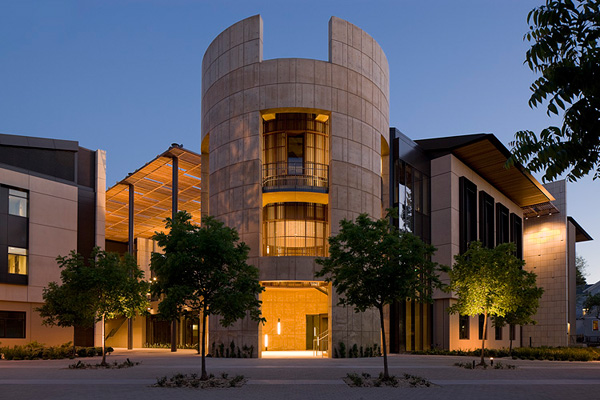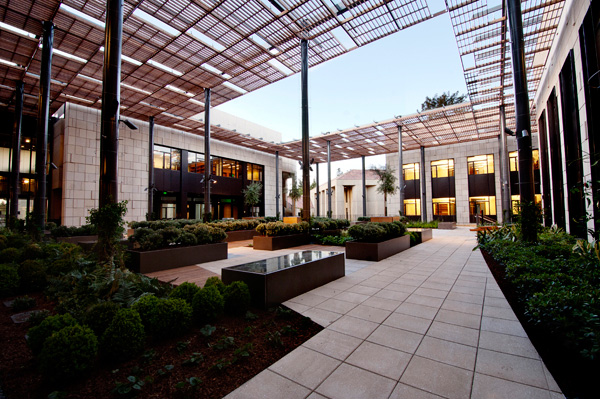U.S. Attorney General Eric Holder to dedicate new building for Stanford Law School
U.S. Attorney General Eric Holder will be on campus Friday to dedicate Stanford Law School's newest building, a striking structure designed to be a central hub of legal education.
The William H. Neukom Building will transform the existing Law School campus into a collaborative open space to stimulate interdisciplinary studies and help cross-pollinate ideas among faculty and students – all in support of the school's vision to transform legal education.
The 65,000-square-foot building is named for William H. Neukom, a 1967 graduate of the Law School who donated the lead gift of $20 million for its construction. Neukom is the managing general partner and CEO of the San Francisco Giants. The dedication ceremony will begin at 3:30 p.m.
"The William H. Neukom building creates a space in which to achieve our goals and is the foundation upon which all else rests," said Law School Dean Larry Kramer. "This building will foster interaction and collaboration, which are essential to a rich educational experience and the kind of intellectual environment that is the hallmark of Stanford Law School."
An open design
The new building is organized around a central open space, reinforcing the principles of the Law School's vision for intellectual openness, as well as Frederick Law Olmsted's original master plan for the university.
A monumental rotunda, Barnum Tower, which references the historic entry gates on Stanford's Main Quad, serves as the building's main entrance. Four three-story wings, connected by glass-walled bridges anchored by a ground-floor plinth, house the Mills Legal Clinic, seminar rooms, faculty offices, open work areas and conference rooms.
The rotunda's open-air staircase leads to the faculty garden and the upper levels, which house offices for faculty, a series of open and closed meeting areas and lounges, and the dean's conference room – a circular, wood-clad, sky-lit space. Faculty suites promote open-door scholarship and establish a welcoming atmosphere for faculty and students. Communal spaces facilitate the kind of informal interaction among faculty and students that is a hallmark of Stanford.
The faculty garden on the second floor, the Jones Courtyard, is the heart of the new building and expands the Law School's outdoor spaces, which include the reinvigorated Crocker Garden and Canfield Court.
The courtyard is composed of multiple materials, including sustainably harvested ipe wood from Brazil. Bold axial connections to adjacent plazas, walkways, malls and building entries further define the Law School's open spaces. Stone and corrugated concrete – exterior building materials that are extended to the interior – figuratively reinforce the school's strategic connection with other disciplines within the university.
Sustainable construction
The building reflects the university's sustainability initiative and satisfies the equivalent of a LEED Gold Certification by meeting key sustainability requirements in the areas of site planning; water management; energy use; materials, resources and waste; indoor environmental quality; and innovation and design.
For example, by maximizing the use of natural light, automated control systems, ceiling fans, efficient glass and an exterior trellis to maximize shade, the new building will use 30 percent less energy than California's stringent code requires. The floor systems in Crocker Garden and the terrace facilitate the collection of rainwater. Local plant species were selected to reduce water use, while pre-existing redwood trees were left untouched. Indoor air quality is optimized through natural ventilation.
The new landscape of legal education
"Stanford Law School is dedicated to educating students who will become leaders in their profession and in their communities – in a world that is increasingly complex and ever changing," Neukom said. "It is my hope that this new building will enhance the learning experience at a law school that prepares and inspires our students and faculty to make a difference."
Neukom, managing general partner and CEO of the San Francisco Giants and former American Bar Association president and Microsoft general counsel, is counted among Stanford Law School's most prominent graduates. He has a long history of providing leadership within the alumni community. He has served as a member of the Dean's Strategic Council since 2000 and as a member of the Board of Visitors Executive Committee since 2003. The William H. Neukom Professor of Law at Stanford Law School was established in 2002. The chair supports faculty working in Neukom's fields of interest, namely human rights, intellectual property rights, ethics and legal responsibility, global rule of law issues, and antitrust and consumer protection.
Kramer, dean of the Law School, has high aspirations for the school's future. "We can continue to develop a model of legal education that prepares lawyers for the changing terrain of the profession. Globalization, the new economy, the information revolution and other changes demand that we transform legal education as much as they do business, government and the legal profession," he said.
"And no law school in the nation is better suited than Stanford to prepare students for these fundamental shifts in the profession and in society."
Stanford President John Hennessy and Board of Trustees Chair Leslie Hume will join Neukom, Holder and Kramer at the dedication.
Media Contact
Judith Romero, Stanford Law School Public Affairs: (650) 723-2232, judith.romero@stanford.edu
Dan Stober, Stanford News Service: (650) 721-6965, dstober@stanford.edu



Share This Story